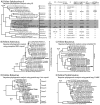Feline fecal virome reveals novel and prevalent enteric viruses
- PMID: 24793097
- PMCID: PMC4080910
- DOI: 10.1016/j.vetmic.2014.04.005
Feline fecal virome reveals novel and prevalent enteric viruses
Abstract
Humans keep more than 80 million cats worldwide, ensuring frequent exposure to their viruses. Despite such interactions the enteric virome of cats remains poorly understood. We analyzed a fecal sample from a single healthy cat from Portugal using viral metagenomics and detected five eukaryotic viral genomes. These viruses included a novel picornavirus (proposed genus "Sakobuvirus") and bocavirus (feline bocavirus 2), a variant of feline astrovirus 2 and sequence fragments of a highly divergent feline rotavirus and picobirnavirus. Feline sakobuvirus A represents the prototype species of a proposed new genus in the Picornaviridae family, distantly related to human salivirus and kobuvirus. Feline astroviruses (mamastrovirus 2) are the closest known relatives of the classic human astroviruses (mamastrovirus 1), suggestive of past cross-species transmission. Presence of these viruses by PCR among Portuguese cats was detected in 13% (rotavirus), 7% (astrovirus), 6% (bocavirus), 4% (sakobuvirus), and 4% (picobirnavirus) of 55 feline fecal samples. Co-infections were frequent with 40% (4/10) of infected cats shedding more than one of these five viruses. Our study provides an initial description of the feline fecal virome indicating a high level of asymptomatic infections. Availability of the genome sequences of these viruses will facilitate future tropism and feline disease association studies.
Keywords: Enteric virus; Felis catus; Metagenomics; Sakobuvirus; Virome.
Copyright © 2014 Elsevier B.V. All rights reserved.
Figures




References
-
- Adams MJ, King AM, Carstens EB. Ratification vote on taxonomic proposals to the International Committee on Taxonomy of Viruses (2013) Archives of virology. 2013;158:2023–2030. - PubMed
-
- Ayukekbong J, Lindh M, Nenonen N, Tah F, Nkuo-Akenji T, Bergström T. Enteric viruses in healthy children in cameroon: Viral load and genotyping of norovirus strains. Journal of medical virology. 2011;83:2135–2142. - PubMed
Publication types
MeSH terms
Substances
Associated data
- Actions
Grants and funding
LinkOut - more resources
Full Text Sources
Other Literature Sources
Medical
Miscellaneous

